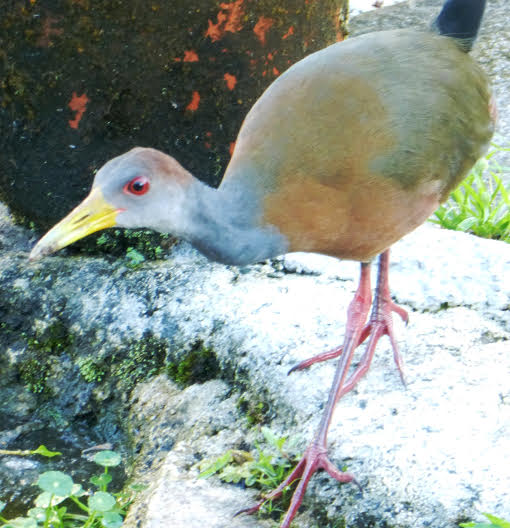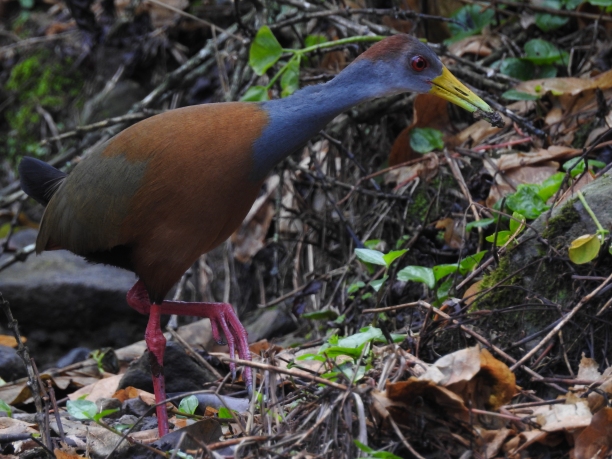Seen a wood-rail lately? Unless you’re up in the north-west in Guanacaste, where the Rufous-necked Wood-Rail (Aramides axillaris) is found, in Costa Rica the only wood-rail you’re going to see is Aramides cajaneus. Oh really? Well, what about Aramides albiventris)? Read on for an attempted explanation.
When I first came to the country, some ten years ago, the only English name for the species was the Gray-necked Wood-Rail (Aramides cajanea) – please note the slight deviation in the Latin (scientific) name since then. Even the latest edition of the standard Costa Rican bird guide (The Birds of Costa Rica (Garrigues & Dean)) still retains this English name for Aramides cajaneus. The species is found pretty much country-wide and was one of the first birds I added to my Costa Rica list, because on our first drive through the country one scampered along the roadside as we followed the Laguna Arenal lakeside road. Here’s an early photo from our Turrialba area, when nomenclature was crystal-clear.

Gray-necked Wood-Rail, as it was then known, at San Rafael de Turrialba
So what happened? Why do we now, since 2016, have not only Aramides cajaneus but also Aramides albiventris? It’s another of those damn splits, of course – all very nice if you want to say that there’s an additional species for the list, but I note that Alexander Skutch, the most knowledgeable Costa Rican ornithologist (A Guide to the Birds of Costa Rica – Stiles & Skutch), mentions no valid basis for a split. The following link to eBird discusses the 2016 split for this species, among others:
http://ebird.org/content/ebird/news/taxonomy-update-for-2016/
Obviously, far wiser heads than mine have looked at the situation and made this split: Aramides cajaneus is now the Russet-naped Wood-Rail, while Aramides albiventris makes its entrance as the Gray-cowled Wood-Rail. The split within Costa Rica was said to be geographical, with cajaneus mostly in the north and down to central Costa Rica and the Caribbean coast to Panama, and albiventris further south and east, on the Pacific side. Here in Turrialba we are in an intermediate region with perhaps both species and we are asked to identify on the basis of russet or grey on the nape, and on the vocalisation, when heard. Some local Tico common names for the species are based on the loud cackling, often heard at dawn or dusk: chirincoco, pone pone, or, as here in Turrialba, pomponé.
Here’s a certified pomponé, i.e. Russet-naped Wood-Rail (Aramides cajaneus), from our local area (Aquiares):

Note the ‘russet’ nape on this bird from the nearby coffee town of Aquiares; photo by John Beer
A little farther away, just west of Turrialba at Peralta, we found this fine pair, both of which also sport the aforementioned nape:

Russet-naped Wood-Rail (Aramides cajaneus) pair at Peralta on the old railway line; photo by John Beer
By contrast birds from further south and east lack the distinctive nape and are now termed Gray-cowled Wood-Rail (Aramides albiventris). The following photo is of an undisputed albiventris from Punta Uva on the Caribbean coast:

Gray-cowled Wood-Rail in the Caribbean; note the solid colour of the back; photo by John Beer
If you now (2018) look at eBird’s species list for our area of Costa Rica you will find that the 2016 split is now not definitive but is instead given as Russet-naped/Gray Cowled Wood-Rail, with no option to split. Does this indicate hybridisation? It certainly means that we cannot indicate which ‘species’ we’re looking at/listening to. Thus the Gray-cowled I definitely heard (but did not see) in my garden a few days ago gets listed as uncertain, while up until now I had seen here in the past only Russet-naped but had not, until now, checked the voice recordings.
So, we have numerous examples of cajaneus from the Turrialba area but not much to verify albiventris. However, take a look at John’s photo of a bird at CATIE, Turrialba, where we usually see cajaneus:

Sure looks like albiventris to us! Photo taken at the CATIE canal in February 2017 by John Beer.
To sum up, we seem to have birds fitting both descriptions in our area, but are these hybrids or individual variations? The experts say vocalisation is a surer distinction than plumage differences but note the brown ‘saddle’ on the back of the Russet-naped in the photos above. It is lacking in the pics of the Gray-cowled, but is this always the case?


Glad to see you have returned to Turrialba. I’m looking forward to reading your excellent posts. We are coming back to Costa Rica again in October. So, if we are lucky, we might see you again.
LikeLike
Hi Allen, hope we can get together in October!
LikeLike
This morning there was one walking in my garden!
LikeLike
Hi Wiet, any chance you can get a photo?
LikeLike
Wood-rails, if only I could see Russet I’m sure this would be easy!
LikeLike
I’m told your eyes will adjust with age!
LikeLike
A rose by any other name . . . It’s still a beautiful bird.
LikeLike